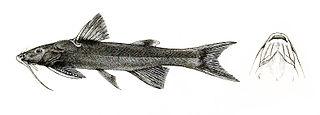
Sisoridae is a family of catfishes. These Asian catfishes live in fast-moving waters and often have adaptations that allow them to adhere to objects in their habitats. The family includes about 235 species.

Glyptothorax is a genus of catfishes order Siluriformes of the family Sisoridae. It is the most species-rich and widely distributed genus in the family with new species being discovered on a regular basis. These species are distributed in the Black Sea basin, northern Turkey, south and east to the Yangtze River drainage in China and south throughout Indo-China to Java, Indonesia. They are found in Asia Minor and southwards to Southeast Asia. The genus is very diverse in the Indian subcontinent. Southeast Asian species tend to have restricted distributions.
Glyptothorax exodon is a species of sisorid catfish.

Glyptothorax kashmirensis is a species of catfish that was described by Sunder Lal Hora in 1923. Glyptothorax kashmirensis is a species in genus Glyptothorax, family Sisoridae and order Siluriformes. IUCN categorise the species as critically endangered globally. No subspecies are listed in Catalogue of Life.
Glyptothorax kudremukhensis is a species of catfish in family Sisoridae and was described by K.C. Gopi in 2007. It is endemic to the Western Ghats and only known from the Tunga River from inside the Kudremukh National Park. IUCN categorises the species as critically endangered. No subspecies are listed in the Catalogue of Life.
Glyptothorax kurdistanicus is a species of sisorid catfish. It is known by several common names, including Mesopotamian sucker catfish, Kordestan catfish and Iran cat. This grey or brown fish with black spots is best known from the Little Zab in Iran and Iraq. It is poorly studied; the full extent of its range is not known and the taxonomic relationships between members of its genus are uncertain.
Glyptothorax armeniacus, the Armenian mountain catfish, is a species of catfish that was first described by Berg, 1918. Glyptothorax armeniacus is a species in genus Glyptothorax, family Sisoridae and order Siluriformes. No subspecies are listed in Catalogue of Life. It is endemic to southern and eastern Turkey.

Glyptothorax annandalei is a species of catfish in the family Sisoridae. It was first described by Indian ichthyologist Sunder Lal Hora in 1923. The IUCN categorises the species as least concern globally.
Glyptothorax alaknandi is a species of catfish that was first described by Tilak, 1969. Glyptothorax alaknandi is a species in genus Glyptothorax, family Sisoridae and order Siluriformes. IUCN categorise the species as least concern globally. No subspecies are listed in Catalogue of Life.
Glyptothorax ater is a species of catfish that was first described by Anganthoibi and Vishwanath in 2011. Glyptothorax ater is a species in genus Glyptothorax, family Sisoridae and order Siluriformes. No subspecies are listed in Catalogue of Life.

Glyptothorax botius is a species of catfish that was first described by Hamilton 1822. Glyptothorax botius is a species in genus Glyptothorax, family Sisoridae and order Siluriformes. IUCN categorise the species as least concern globally. No subspecies are listed in Catalogue of Life.
Glyptothorax buchanani is a species of catfish that was first described by Smith, 1945. Glyptothorax buchanani is a species in genus Glyptothorax, family Sisoridae and order Siluriformes. IUCN categorise the species as insufficiently studied globally. No subspecies are listed in Catalogue of Life.
Glyptothorax cavia is a species of catfish that was first described by Hamilton 1822. Glyptothorax cavia is a species in genus Glyptothorax, family Sisoridae and order Siluriformes. IUCN categorise the species as least concern globally. No subspecies are listed in Catalogue of Life.

Glyptothorax telchitta is a species of fish in the family Sisoridae. This species can be found in Pakistan, India, Bangladesh and Nepal.
Glyptothorax callopterus is a species of catfish that was first described by Smith, 1945. Glyptothorax callopterus is a species in genus Glyptothorax, family Sisoridae and order Siluriformes. IUCN categorise the species as least concern globally. No subspecies are listed in Catalogue of Life.
Glyptothorax caudimaculatus is a species of catfish that was first described by Anganthoibi and Vishwanath 2011. Glyptothorax caudimaculatus is a species in genus Glyptothorax, family Sisoridae and order Siluriformes. No subspecies are listed in Catalogue of Life. It is found in the Kaladan River basin in Mizoram State, India.
Glyptothorax chimtuipuiensis is a species of catfish that was first described by Anganthoibi and Vishwanath 2010. Glyptothorax chimtuipuiensis is a species in genus Glyptothorax, family Sisoridae and order Siluriformes. IUCN categorise the species as insufficiently studied globally. No subspecies are listed in Catalogue of Life.
Glyptothorax chindwinica is a species of catfish that was first described by Vishwanath and Linthoingambi 2007. Glyptothorax chindwinica is a species in genus Glyptothorax, family Sisoridae and order Siluriformes. IUCN categorise the species as least concern globally. No subspecies are listed in Catalogue of Life.

Glyptothorax conirostris is a species of catfish that was first described by Steindachner, 1867. Glyptothorax conirostris is a species in genus Glyptothorax, family Sisoridae and order Siluriformes. IUCN categorise the species as insufficiently studied globally. No subspecies are listed in Catalogue of Life.
Glyptothorax silviae is a species of catfish in genus Glyptothorax, family Sisoridae and order Siluriformes. It is a Freshwater, benthopelagic, Subtropical fish endemic to the Shatt al-Arab and Karun rivers in Iran and Tigris in Iraq.






